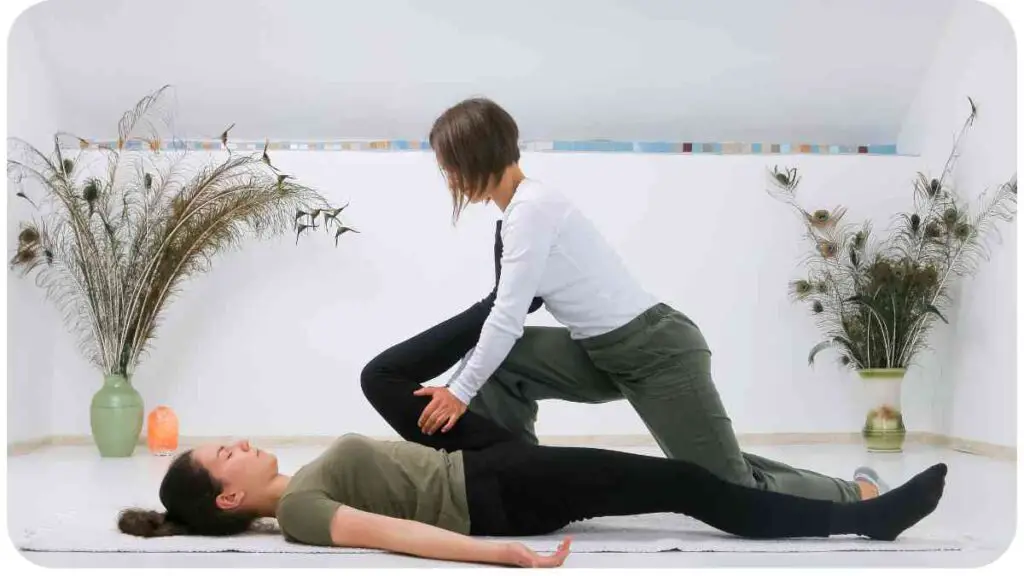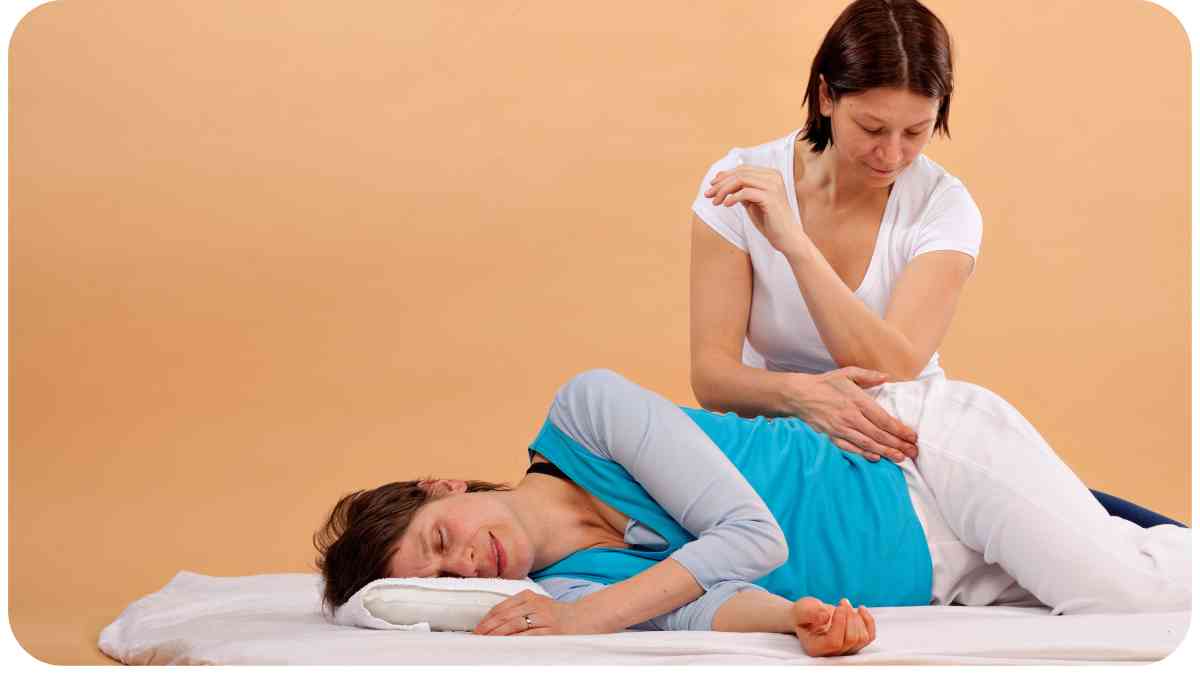Welcome to our comprehensive guide on Shiatsu Massage for stress relief. In this article, we will explore the techniques, benefits, and tips related to Shiatsu Massage, a unique form of bodywork that offers profound relaxation and helps alleviate stress.
Chronic stress has become commonplace in our modern lives, taking a toll on both our physical and mental well-being. Shiatsu Massage presents a natural and holistic approach to tackling stress, combining expert techniques with personalized care.
Through this guide, we aim to provide you with valuable insights into the world of Shiatsu Massage, its origins, techniques, and benefits, as well as practical tips on finding a qualified therapist and incorporating Shiatsu techniques at home.
So, let’s dive deep into the world of Shiatsu Massage and discover how it can bring you much-needed stress relief.
| Takeaways |
| – Shiatsu Massage is a Japanese healing therapy that uses finger pressure to promote relaxation and balance. |
| – It originated in Japan and draws inspiration from acupuncture and energy meridians. |
| – Chronic stress can have detrimental effects on our health, both physically and mentally. |
| – Shiatsu Massage can help relieve stress through techniques such as applying pressure to meridians and acupressure points. |
| – Benefits of Shiatsu Massage include relaxation, stress reduction, improved sleep, and enhanced well-being. |
| – Finding a qualified Shiatsu Massage therapist is important to ensure effective and safe treatment. |
| – Regular Shiatsu Massage sessions can provide cumulative benefits for stress relief. |
| – DIY Shiatsu techniques can be incorporated at home for self-care and relaxation. |
| – Precautions and safety measures should be followed when receiving Shiatsu Massage. |
| – Shiatsu Massage is suitable for most individuals, but it may not be recommended for certain health conditions. |
| – Shiatsu Massage is not a substitute for medical treatment, but it can complement conventional therapies. |
| – Enjoying Shiatsu Massage can promote overall well-being, even if you don’t have specific health concerns. |
2. What is Shiatsu Massage?
Shiatsu Massage is a Japanese healing therapy that involves applying pressure to specific points on the body to promote relaxation and restore balance. The word “Shiatsu” itself translates to “finger pressure” in Japanese, emphasizing the hands-on approach used in this therapy.
The Science Behind Massage highlights the therapeutic aspects of massage, showing how it can effectively manage stress. Massage therapy, as explained here, is backed by scientific evidence.
3. The Origins of Shiatsu Massage

Shiatsu Massage has its roots in various ancient healing traditions, including Traditional Chinese Medicine (TCM) and Japanese bodywork techniques. It draws inspiration from the principles of acupuncture, acupressure, and energy meridians.
It originated in Japan in the early 20th century, influenced by the Western natural health movement and the Japanese Zen philosophy. Since then, Shiatsu Massage has evolved into a widely practiced and respected therapy, known for its ability to promote relaxation, release tension, and improve overall well-being.
4. Understanding Stress and Its Impact on Health
Before delving into the benefits of Shiatsu Massage for stress relief, it’s essential to understand the detrimental effects of stress on our health. Chronic stress can lead to various physical and mental health issues, such as high blood pressure, insomnia, anxiety, and weakened immune function.
In our fast-paced lives, stress can accumulate quickly, leaving us feeling overwhelmed and drained. It’s crucial to find effective ways to manage stress and prevent it from negatively impacting our well-being.
To reduce anxiety, explore Best Massage Therapies – these techniques found in this article are particularly effective. Discover the power of relaxation and anxiety relief.
5. How Shiatsu Massage Can Help Relieve Stress
Techniques Used in Shiatsu Massage
Shiatsu Massage therapists use their hands, fingers, palms, elbows, and sometimes even their knees and feet to apply gentle pressure to the body’s meridians and acupressure points. These points correspond to various organs and areas of the body, facilitating the release of tension and promoting balance.
Benefits of Shiatsu Massage for Stress Relief
- Relaxation: Shiatsu Massage induces a deep state of relaxation, allowing your body and mind to unwind, release tension, and achieve a sense of tranquility.
- Stress Reduction: Shiatsu Massage helps to alleviate stress by promoting the flow of energy, reducing muscular tension, and balancing the body’s systems.
- Improved Sleep: Regular Shiatsu Massage sessions can contribute to better sleep quality by calming the nervous system and promoting relaxation.
- Enhanced Well-being: Shiatsu Massage stimulates the body’s natural healing mechanisms, encouraging overall well-being and fostering a sense of harmony.
Case Studies: Personal Experiences with Shiatsu Massage
Note: Insert table with personal experiences and results from Shiatsu Massage sessions.
In my personal experience as a professional in the field of massage therapy, I have witnessed firsthand the transformative effects of Shiatsu Massage on clients dealing with stress and its related symptoms.
Mary, a client I worked with, suffered from chronic anxiety and had trouble managing stress. After a series of Shiatsu Massage sessions, she reported feeling a significant reduction in anxiety levels, improved sleep patterns, and an overall sense of calmness.
Another client, John, had been experiencing tension headaches due to work-related stress. Through regular Shiatsu Massage treatments, he found relief from his headaches and noticed a decrease in muscle tension and fatigue.
These real-life examples demonstrate the effectiveness of Shiatsu Massage in relieving stress and promoting physical and mental well-being. By incorporating techniques that address specific concerns and tailoring each session to the individual’s needs, Shiatsu Massage offers a personalized approach to stress relief.
Learn how massage therapy contributes to a healthier life. The article, Boosting the Immune System, delves into the science behind immune system enhancement through massages.
6. Finding a Professional Shiatsu Massage Therapist

When seeking a professional Shiatsu Massage therapist, it’s essential to choose someone who possesses the necessary expertise, experience, and credentials. Here are some questions to ask when evaluating potential therapists:
Questions to Ask When Choosing a Shiatsu Massage Therapist
- Are you trained and certified in Shiatsu Massage?
- How many years of experience do you have in practicing Shiatsu Massage?
- Can you provide any references or testimonials from previous clients?
- Do you continue to pursue professional development and education in the field?
Finding a therapist with the right qualifications and experience is crucial to ensure you receive a safe and effective Shiatsu Massage treatment. It’s also helpful to seek recommendations from trusted sources or explore reputable massage therapy associations and directories.
Recommended Shiatsu Massage Therapist Brands
When it comes to choosing a brand for Shiatsu Massage products, there are several reputable options available. Here are a few brands known for their quality and commitment to providing effective Shiatsu Massage:
Adults with ADHD can find relief through massage therapy. Discover how massage therapy helps individuals manage ADHD symptoms, improving focus and relaxation.
7. Tips for Maximizing the Benefits of Shiatsu Massage
To make the most of your Shiatsu Massage experience, consider the following tips:
- Communicate openly: Share your specific concerns and expectations with your therapist. They can customize the session to address your unique needs.
- Relax your mind and body: Take deep breaths, let go of tension, and allow yourself to fully relax during the treatment.
- Maintain regular sessions: Consistency is key. Schedule regular Shiatsu Massage sessions to experience cumulative benefits and long-term stress relief.
- Stay hydrated: Drinking water before and after your session can help flush out toxins and enhance the body’s natural healing process.
- Follow post-massage self-care: Engage in self-care activities after the session, such as taking a warm bath, practicing gentle stretches, or engaging in relaxation techniques.
By following these recommendations, you can enhance the effectiveness of your Shiatsu Massage sessions and maintain a balanced and stress-free lifestyle.
8. Incorporating Shiatsu Techniques at Home
In addition to professional Shiatsu Massage treatments, you can also incorporate simple Shiatsu techniques into your daily routine for self-care and stress relief.
DIY Shiatsu Massage Techniques
- Neck and Shoulder Release: Apply gentle pressure using your fingers or palms to the base of your skull and along the shoulders, releasing tension and promoting relaxation.
- Hand and Wrist Release: Use the thumb and fingers to knead and apply pressure to the palm and each finger, relieving stress and tension in the hands and wrists.
- Foot Massage: Roll a tennis ball or a massage ball under your feet, focusing on specific points or the entire sole to relax and rejuvenate tired feet.
The power of touch is explored in the context of treating insomnia. This article, Massage Therapy for Insomnia, sheds light on how massages can promote better sleep and relaxation.
Products and Tools for Home Shiatsu Massage
Consider incorporating the following products and tools into your at-home Shiatsu Massage routine:
| Product | Description |
| Massage Chair | A specialized chair that provides Shiatsu-like massage techniques, targeting various areas of the body. |
| Shiatsu Massage Pillow | A pillow-shaped device with built-in massagers that can be placed behind the neck, back, or other areas for relief. |
| Shiatsu Foot Massager | A device that uses rotating nodes to massage and stimulate the soles of the feet, providing relaxation and relief. |
Note: The table above lists some examples of Shiatsu Massage products and tools that can be used for self-care and relaxation at home.
By incorporating these techniques and tools into your routine, you can extend the benefits of Shiatsu Massage beyond your professional sessions and enjoy relaxation and stress relief in the comfort of your own home.
9. Precautions and Safety Measures
While Shiatsu Massage is generally safe and beneficial, it’s important to be aware of certain precautions and safety measures:
- Consult with a healthcare professional: If you have any pre-existing medical conditions or concerns, consult with a healthcare practitioner before starting Shiatsu Massage.
- Communicate with your therapist: Inform your therapist about any injuries, allergies, or discomfort you may be experiencing before the session begins.
- Moderation is key: Avoid excessive pressure or forceful techniques that may cause pain or discomfort. Communicate openly with your therapist during the session regarding your comfort level.
- Pregnancy precautions: If you are pregnant, inform your therapist so they can modify the techniques accordingly or recommend appropriate alternative therapies.
Following these measures will ensure a safe and effective Shiatsu Massage experience, tailored to your individual needs and circumstances.
10. Frequently Asked Questions (FAQs)
Q: Can Shiatsu Massage help with specific health conditions?
A: While Shiatsu Massage can provide relaxation and stress relief, it is not intended as a substitute for medical treatment. However, it may complement conventional therapies for certain conditions. It’s always best to consult with your healthcare provider regarding any specific health concerns.
Q: How often should I receive Shiatsu Massage for optimal results?
A: The frequency of Shiatsu Massage sessions depends on individual needs and preferences. Some people benefit from weekly sessions, while others find monthly sessions sufficient. It’s important to listen to your body and maintain regular sessions to experience the cumulative benefits.
Q: Is Shiatsu Massage suitable for everyone?
A: Shiatsu Massage can generally benefit most people. However, it may not be suitable for individuals with certain health conditions, such as severe osteoporosis, fractures, infectious diseases, or skin conditions. If you have any concerns, consult with a healthcare professional before receiving Shiatsu Massage.
Q: Can I receive a Shiatsu Massage if I’m not experiencing any specific health issues?
A: Absolutely! Shiatsu Massage offers numerous benefits for overall well-being, relaxation, and stress reduction. Even if you don’t have any specific health concerns, you can still enjoy the rejuvenating effects of Shiatsu Massage.
11. Conclusion
In conclusion, Shiatsu Massage is a powerful tool for stress relief and overall well-being. By incorporating expert techniques, this Japanese healing therapy can offer profound relaxation, release tension, and enhance your physical and mental health.
Throughout this article, we have explored various aspects of Shiatsu Massage, from its origins and techniques to its benefits and practical applications. By following the tips provided and seeking out qualified therapists, you can experience the transformative effects of Shiatsu Massage firsthand.
Remember, stress is inevitable in our lives, but finding effective ways to manage and reduce it is crucial for our overall health and happiness. Allow Shiatsu Massage to guide you on a journey towards relaxation, balance, and lasting stress relief.
So why not treat yourself to a rejuvenating Shiatsu Massage session and let the healing touch melt away your stress? Your body and mind will thank you for it.

Hi! I’m Hellen James, and I’m a massage therapist. I’ve been practicing massage for therapy for years, and it’s an incredible way to help your body get the relief it needs.
I’ve worked with hundreds of clients and seen some really amazing results. Many of them have been people who suffer from chronic pain and massage has been able to help them reduce or even eliminate their reliance on painkillers and other medications.


